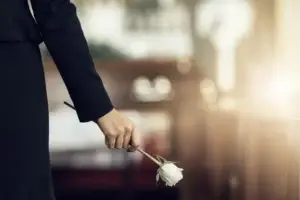Attending a funeral is a solemn occasion, and choosing the right attire is more than a matter of dress code—it’s a way to express respect and empathy for the bereaved and honor the memory of the deceased. Understanding what to wear to a funeral is essential not only to show respect but also to ensure that you are appropriately dressed for the gravity of the event. This guide aims to help you navigate the nuances, offering clarity and support as you prepare to pay your respects.
Throughout this guide, we will explore various aspects of funeral attire, from traditional expectations to appropriate choices for different types of funerals. Whether you are attending a service for the first time or looking for guidance on how to dress for a funeral under specific circumstances, this guide will provide you with the necessary information to make respectful and thoughtful choices about your attire.
Understanding Funeral Etiquette
When preparing for a funeral, the etiquette surrounding attire is not merely about following tradition but also about showing respect and empathy towards the grieving family and honoring the memory of the deceased. Understanding what to wear to a funeral involves grasping the broader expectations that are generally accepted during such solemn occasions.
General Expectations for Funeral Attire
The general expectations for funeral attire are typically conservative, favoring darker colors which symbolize mourning and respect. For men, this often means a dark suit or a button-down shirt with a jacket and tie, paired with dress shoes. For women, conservative dresses, skirts at or below the knee, or dress pants combined with a blouse, are considered appropriate. It’s also crucial to consider the weather and choose attire that is not only respectful but also practical for the climate.
Respecting Cultural and Family Wishes
Beyond the basics of color and formality, respecting cultural and family wishes plays a critical role in deciding how to dress for a funeral. Different cultures and religions may have specific requirements or traditions for funeral attire, ranging from color choices to particular types of clothing. For instance, some cultures prefer white at funerals, symbolizing purity and rebirth, while others may require head coverings or specific ceremonial garments.
Acknowledging these preferences and incorporating them into your choice of attire is a fundamental aspect of funeral etiquette. It reflects a deep respect for the beliefs and feelings of the bereaved, ensuring that your presence at the funeral supports the family during their time of loss. By carefully considering what to wear to a funeral, attendees can contribute to a dignified and respectful atmosphere, allowing the focus to remain on commemorating the life of the departed.
Traditional Funeral Attire
When attending a funeral, especially within Western cultures, there are specific traditional attires that are expected to be worn. This section offers detailed guidelines to ensure you meet these expectations while also respecting the solemnity of the occasion.
Guidelines for Traditional Western Funeral Attire
For Men
In traditional Western funeral attire, men are expected to wear a dark suit and tie, which conveys respect and solemnity. A plain white or light-colored dress shirt under a black or dark navy jacket is standard. Dark dress shoes and a matching belt complete the outfit, embodying a dignified appearance suitable for the occasion.
For Women
For women, appropriate attire includes a simple, dark dress or a conservative skirt and blouse combination. Dresses or skirts should be knee-length or longer, and shoulders should generally be covered, either by the dress itself or with a shawl or jacket. Closed-toe shoes in dark colors are recommended. Jewelry should be kept minimal and understated to maintain the somber mood.
Adapting to Different Climates and Seasons
Choosing what to wear to a funeral also involves considering the climate and season to ensure comfort while still respecting the dress code. In warmer climates or during summer months, lighter fabrics like linen or light wool can be worn, but the colors should still remain dark and subdued. In colder weather, heavier fabrics such as tweed or a thicker wool suit for men, and wool dresses or suits for women, are appropriate. Adding a tasteful overcoat or a scarf can provide additional warmth without detracting from the formality of the occasion.
Considerations for Different Types of Funerals
When attending a funeral, it’s important to recognize that different types of ceremonies—such as military, religious, or culturally specific funerals—may require variations in attire. This section will guide you through how attire might change depending on the nature of the funeral and highlight the importance of being informed about what to wear to a funeral in these varied contexts.
Attire for Military Funerals
Military funerals often have specific protocols and dress codes, especially for those who are serving or have served in the military. For civilian attendees, it is appropriate to wear smart, conservative clothing. Men might wear a dark suit and tie, while women should opt for a simple, conservative dress or a suit. Medals or military ribbons may be worn by those who have served, which should be displayed according to military guidelines.
Attire for Religious and Cultural Funerals
Different religions and cultures can have unique traditions that extend to funeral attire. For example:
- Islamic Funerals: Modesty is key. Men and women should both aim to cover as much skin as possible; women might consider wearing a headscarf.
- Jewish Funerals: Traditional attire includes a head covering (kippah for men, and a hat or scarf for women), and men generally wear a suit.
- Hindu Funerals: White is often worn instead of the typical Western black, symbolizing purity and rebirth.
- Buddhist Funerals: White is also commonly worn by attendees as a sign of respect and mourning.
Understanding these nuances and respecting the wishes of the deceased’s family by dressing appropriately can greatly contribute to the solemnity and dignity of the service. It’s crucial to research beforehand or ask the family about any specific attire requirements associated with their religious or cultural practices.
What to Avoid Wearing at a Funeral
Choosing appropriate attire for a funeral is not only about knowing what to wear to a funeral but also understanding what not to wear. Inappropriate funeral attire can detract from the solemnity of the occasion and may even be seen as disrespectful. Here are some key types of clothing and styles to avoid:
Inappropriate Styles
- Casual Clothing: Items like jeans, t-shirts, shorts, and casual footwear such as sneakers or flip-flops are generally not suitable for funerals. These convey a casualness that is out of place at a solemn event.
- Overly Flashy or Attention-Grabbing Outfits: Bright, flashy colors and patterns, or clothing that is overly ornate with excessive embellishments should be avoided. Funerals are not occasions for fashion statements; the focus should be on mourning and remembrance.
- Revealing Clothing: Low-cut tops, short skirts, and dresses, or any attire that is overly revealing should be avoided. Modesty is key in funeral attire to maintain the respectful tone of the event.
Inappropriate Colors
While black is traditionally worn at Western funerals as a sign of mourning, there are other colors that are generally considered inappropriate:
- Bright Colors: Bold and bright colors like red, orange, or bright yellow can be seen as disrespectful as they can stand out too much against the somber backdrop of a funeral service.
- Neon Colors: These are far too casual and flashy for the dignity of a funeral.
Special Considerations
It’s important to also consider any specific wishes the family might have mentioned regarding attire. In some cases, families might request attendees wear a certain color to celebrate the life of the deceased instead of mourning their death, such as their favorite color or white to symbolize their passing into the afterlife peacefully. Always respect these wishes when provided.
Accessories and Color Choices
Selecting the right accessories and understanding the significance of color choices are essential aspects of dressing appropriately for a funeral. This section will guide you through the nuances of accessorizing and choosing colors that are respectful and fitting for such an occasion.
Acceptable Accessories
When it comes to accessorizing for a funeral, less is more. The goal is to complement the solemnity of the event without drawing undue attention to oneself.
- Jewelry: Opt for subtle and understated pieces. A simple watch, a pair of small earrings, or a modest necklace can be appropriate. Avoid flashy or large jewelry that might be distracting.
- Belts: Choose a belt that matches your shoes in color and style. It should be simple and not overly decorative.
- Shoes: Footwear should be conservative and comfortable for standing or walking during the service. Closed-toe shoes in dark colors are most suitable. Men should wear dress shoes, while women can opt for low-heeled shoes or flats.
- Hats and Scarves: In some cultures or during outdoor services, hats or scarves might be appropriate. Choose subdued colors and simple styles. For example, a plain black hat or a simple scarf can be worn for warmth or protection against the elements.
Significance of Color Choices
The colors you choose to wear to a funeral can convey deep symbolic meanings and should be selected with care.
- Black: Traditionally, black is the most common color worn at funerals in many cultures, symbolizing mourning and respect for the deceased.
- Dark Grays and Navy: These are acceptable alternatives to black and also convey solemnity and respect.
- White: In some Eastern cultures, white is worn to symbolize purity and rebirth. In Western cultures, it’s more common to wear white as an accent color, such as a blouse under a dark jacket or a white handkerchief.
It’s important to consider the family’s wishes or cultural norms when selecting colors. Some families might request brighter colors to celebrate the life of the deceased instead of mourning their death. In such cases, following the family’s directives shows respect for their preferences.
By choosing accessories and colors thoughtfully, attendees can ensure their attire is appropriate and respectful, reinforcing the decorum expected at a funeral. This attention to detail in what to wear to a funeral not only shows respect for the deceased and their loved ones but also contributes to the overall solemnity of the service.
Children’s Attire at Funerals
Dressing children for a funeral requires thoughtful consideration to ensure their attire is appropriate and respectful for the solemn occasion. While children are not expected to adhere as strictly to traditional funeral dress codes as adults, their clothing should still reflect the dignity of the event. Here are some guidelines and tips to help dress children suitably for funerals.
Choosing Appropriate Attire for Children
- Color and Style: Opt for subdued colors like black, navy, or dark grey for children’s clothing. These colors are traditionally associated with mourning and show respect for the occasion. Choose simple styles that are conservative and not overly casual or festive. For boys, a dark suit or slacks with a dress shirt can be appropriate. For girls, a dark dress or a skirt and blouse combination works well.
- Comfort and Practicality: It’s important to choose outfits that are comfortable for children, as they may need to sit or stand for extended periods during the service. Make sure the clothing fits well and is suitable for the weather, especially if part of the service is held outdoors.
- Footwear: Like adults, children should wear conservative shoes. Dark-colored dress shoes or flats are appropriate. Avoid sneakers or overly bright or embellished footwear.
Accessorizing Thoughtfully
Minimal Accessories: If accessories are necessary, keep them minimal and subdued. A simple headband or a pair of dark socks can complement the outfit without becoming a distraction.
Outerwear: For colder weather, ensure children have appropriate outerwear such as a dark coat or jacket that matches the formality of their outfit. This will keep them comfortable and ensure their attire remains appropriate for the occasion.
Preparing Children for the Funeral
- Explaining the Event: Help children understand the significance of the event and why it’s important to dress respectfully. This can make the process of choosing an outfit a learning experience about respect and traditions.
- Practical Considerations: Prepare for unexpected issues such as spills or discomfort by bringing along a change of clothes or extra layers that are also in keeping with the funeral’s dress code.
Dressing children appropriately for a funeral not only shows respect for the deceased and their family but also teaches children about the importance of presentation and decorum during significant events. By ensuring children’s outfits align with what to wear to a funeral guidelines, parents can contribute to the respectful atmosphere of the service.
Last-Minute Tips and Reminders
Before attending a funeral, it’s crucial to double-check your attire to ensure it is appropriate and respectful for the occasion. Here is a quick checklist to help you review your outfit and a summary reminder of what to wear to a funeral.
Quick Checklist Before Attending a Funeral
- Outfit Selection: Ensure your chosen attire adheres to the guidelines for conservative and respectful clothing. Double-check for any accidental stains, wrinkles, or tears that might need last-minute attention.
- Appropriate Colors: Confirm that your outfit is in an appropriate color, typically black, navy, or dark gray. Avoid any overly bright or flashy colors unless specifically requested by the family.
- Fit and Comfort: Make sure your clothing fits well and allows for comfort during the service, especially if you’ll be standing or sitting for long periods.
- Footwear: Verify that your shoes are clean, polished, and appropriate for a solemn occasion. Ensure they are comfortable, especially if you anticipate standing or walking during the service.
- Accessories: Keep accessories minimal and tasteful. Check that any jewelry, belts, or other items are subdued and do not detract from the somberness of the event.
Honoring the Departed with Dignity and Respect
As you prepare to attend a funeral, remembering the key guidelines on what to wear to a funeral can make a significant difference in showing your respect and support for the bereaved family. At McCafferty Funeral & Cremation Inc., we understand the importance of these moments and the need for a dignified presence to honor the memory of the departed.
If you have any questions about funeral etiquette, or if you need assistance planning a funeral, please do not hesitate to contact McCafferty Funeral & Cremation Inc. Our experienced staff is here to provide support and guidance during these challenging times, ensuring that every detail is handled with care and respect.
Reach out to us at McCafferty Funeral & Cremation Inc., where we are committed to serving the community with dignity and compassion. Let us help you prepare for a service with the solemnity and respect it deserves.




